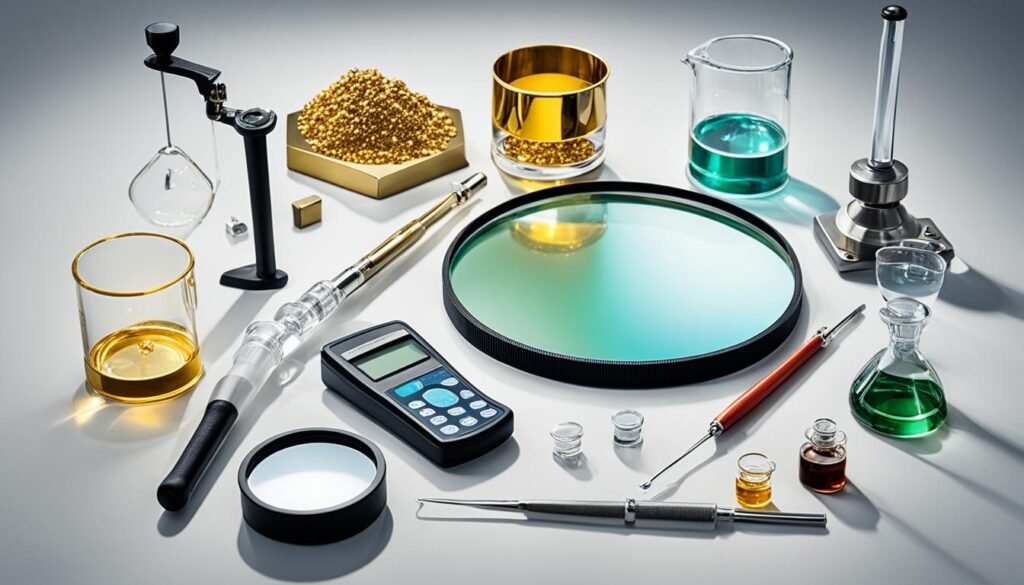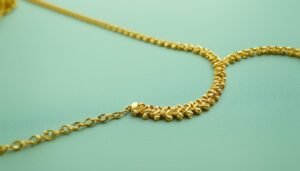Have you ever wondered why your gold jewelry doesn’t behave like the classic, magnetic metals we often encounter in daily life?
The magnetic properties of gold carry a mystique that has perpetuated numerous myths and misconceptions. Despite being a precious and dense element, pure gold remains famously non-magnetic.
If you notice any magnetic reaction in your gold, it might signal the presence of impurities or even a counterfeit piece. To truly understand gold authenticity, one must delve into various testing methods – from weight assessment and density calculations to direct tests like magnetism and acid evaluations. These procedures allow us to accurately recognize real gold by understanding its unique properties and distinguishing it from imitations.
Key Takeaways about Pure Gold and Its Magnetism
- Pure gold is non-magnetic, unlike many popular assumptions.
- A magnetic response in gold signals possible impurities or counterfeit materials.
- Gold testing methods include magnetism, acid tests, weight assessments, and density calculations.
- Understanding gold’s properties is essential in distinguishing genuine gold from fakes.
- Knowledge of gold authenticity helps in making informed purchasing and valuation decisions.
Understanding the Properties of Pure Gold
Pure gold is renowned for its unique set of properties, each contributing to its prevalence in various applications and its high value in the market. Let’s delve deeper into these properties to understand what makes pure gold so extraordinary.
Density and Weight
One of the most remarkable properties of pure gold is its high density. With a gold density of 19.3 grams per cubic centimeter, it appears significantly heavier than it looks. This attribute is particularly useful in differentiating pure gold from other materials, as its considerable weight can often be felt in the hand. The density remains fairly consistent across different karats of gold, though slight variations do occur due to the presence of alloying metals in lower karat gold.
Karat and Purity
The karat system is used to measure gold purity, with 24 karat representing pure gold. This system is crucial for consumers and jewelers alike, as it provides a standardized measure of gold content. For instance, 18 karat gold contains 75% pure gold, with the remaining 25% consisting of other metals such as copper or silver. Understanding the karat system helps in evaluating the quality and value of gold items effectively.
Common Uses and Hallmarks
Due to its resistance to tarnishing, gold is extensively used in jewelry and other decorative items that require longevity and enduring brilliance. Each piece of genuine gold is typically stamped with hallmarks that indicate its purity (karat weight) and often the manufacturer’s name, serving as a mark of authenticity. These hallmarks are critical for both buyers and sellers in verifying the authenticity and purity of gold items.
Furthermore, gold also finds application in electronics, dentistry, and various industrial fields due to its excellent conductivity and non-reactive nature. Its versatile applications, coupled with its inherent properties, make gold one of the most sought-after metals globally.
Why Pure Gold is Not Magnetic
Gold’s lack of magnetism can be attributed to its atomic structure. As a non-ferrous metal, gold does not possess a configuration that supports the alignment of magnetic domains. Hence, pure gold is classified among the non-magnetic metals, and it does not exhibit any *gold magnetic properties*.
If a gold item is attracted to a magnet, it is a strong indicator that the piece might not be pure gold.

The magnetism test is a straightforward method to authenticate gold. Various metals magnetize under certain conditions, but *non-magnetic metals*, such as pure gold, show no such reaction.
Given the rise in counterfeit products, understanding these *gold magnetic properties* is crucial for verifying the metal’s authenticity. When dealing with gold items, always consider this essential characteristic to avoid potential frauds involving magnetic metals.
| Metal | Magnetic Properties | Usage |
|---|---|---|
| Gold | Non-Magnetic | Jewelry, electronics, currency |
| Iron | Magnetic | Construction, machinery |
| Copper | Non-Magnetic | Electrical wiring, plumbing |
| Nickel | Magnetic | Coins, batteries |
Tests to Identify Pure Gold
When it comes to distinguishing real gold from counterfeits, several gold testing methods can be utilized for accurate gold verification. Here are some straightforward and reliable tests to consider.
Magnetic Test
One of the quickest gold testing methods is the magnetic test. Using a strong magnet, not just a regular refrigerator magnet, identify if the gold piece is attracted to it. Since real gold is non-magnetic, a genuine piece will show no attraction. This test helps in initial gold verification by immediately ruling out non-gold items that exhibit magnetic properties.
Float Test
The float test is another effective method for gold verification. Place the gold item in a bowl of water. Real gold, owing to its high density, will sink to the bottom, whereas many counterfeits will float or even dissolve. This straightforward test is highly effective, reinforcing the reliability of gold testing methods.

These simple yet effective tests can be supplemented with more detailed assessments like the streak test and the nitric acid test, providing comprehensive gold verification for all sorts of gold items.
Pure Gold and Its Magnetism: Setting Facts Straight
When debunking gold myths, it’s crucial to focus on the authentic characteristics of pure gold. One of the most persistent misconceptions is that gold is magnetic. Pure gold, however, is non-magnetic. Genuine gold has an atomic structure that does not allow for the alignment of magnetic domains.

Counterfeit gold products, often mixed with magnetic metals, can exhibit magnetic properties. This has led to confusion among consumers trying to assess their gold’s authenticity. While some substitutes and simulated gold will respond to magnetic forces, pure gold remains unaffected.
In some experimental processes, such as electrolyte gating, scientists have induced magnetism in typically non-magnetic materials like pyrite. Unfortunately, this can sometimes lead to pyrite being mistaken for gold due to its similar appearance. Therefore, understanding gold magnetism facts is essential.
“The more you know about the true properties of gold, the better equipped you are to distinguish real gold from imitations.”
By being well-informed, consumers can make more confident and accurate decisions when purchasing or testing gold items. This knowledge not only helps in identifying genuine gold but also protects against potential frauds. Debunking gold myths and understanding the scientific facts behind gold’s magnetism ensures clarity and accuracy in recognizing real gold.
Conclusion
In my exploration of pure gold and its magnetism, it’s clear that understanding the fundamental properties of gold is crucial for anyone looking to invest in or validate this precious metal. Pure gold’s non-magnetic nature is a definitive characteristic that distinguishes it from many counterfeit and impure forms. The presence of magnetic behavior in gold items typically signals impurity or fraudulent composition, emphasizing the importance of thorough verification methods.
When it comes to identifying genuine gold, several reliable tests stand out. Inspecting hallmarks, conducting density checks, and applying both the magnetism and float tests are effective ways to assess authenticity. Analyzing these aspects provides a comprehensive understanding of gold’s true nature. Through this, consumers can more confidently navigate the market and make informed decisions about their gold purchases.
The final thoughts on gold magnetism highlight a combination of scientific facts and practical advice. By leveraging knowledge about gold’s properties, one can significantly reduce the risk of falling prey to counterfeit products. This journey through gold’s magnetism serves not only as a scientific inquiry but as a practical guide, equipped to help consumers validate their gold possessions with confidence.
FAQ about Pure Gold and Its Magnetism
Is pure gold magnetic?
No, pure gold is not magnetic. Its atomic structure as a non-ferrous metal means it does not exhibit any magnetic properties. If a gold item is attracted to a magnet, it indicates impurity or that it contains other magnetic metals.
How can I test the authenticity of gold?
There are several methods to test for gold authenticity, including the weight and density assessments, magnetism test, float test, and nitric acid test. Real gold will not be attracted to a magnet, will sink in water, and will pass the acid test without reacting.
What does the karat system signify in gold purity?
The karat system is used to measure gold purity. Pure gold is 24 karats, indicating 100% gold. Lower karat values represent gold mixed with other metals. Common ratios include 18k (75% gold) and 14k (58.3% gold).
Why is gold’s density important in identifying its purity?
Gold’s high density of 19.3 grams per cubic centimeter is a key indicator of its purity. This density remains consistent across different karat values, making it crucial in verifying genuine gold, as counterfeit items typically have lower densities.
What are the hallmarks on gold items?
Hallmarks on gold items usually indicate their karat weight and sometimes the manufacturer’s name. These stamps provide assurance of both the purity and authenticity of the gold.
Can gold tarnish, and if it does, what does it indicate?
Pure gold does not tarnish. If a gold item shows signs of discoloration or tarnish, it likely contains impurities or is not real gold. This quality makes gold ideal for long-lasting jewelry and decorative items.
What is the significance of the float test for gold?
The float test is used to verify the density and purity of gold. Real gold, due to its density, will sink when placed in water. Most counterfeit gold items will float, thus failing this test.








